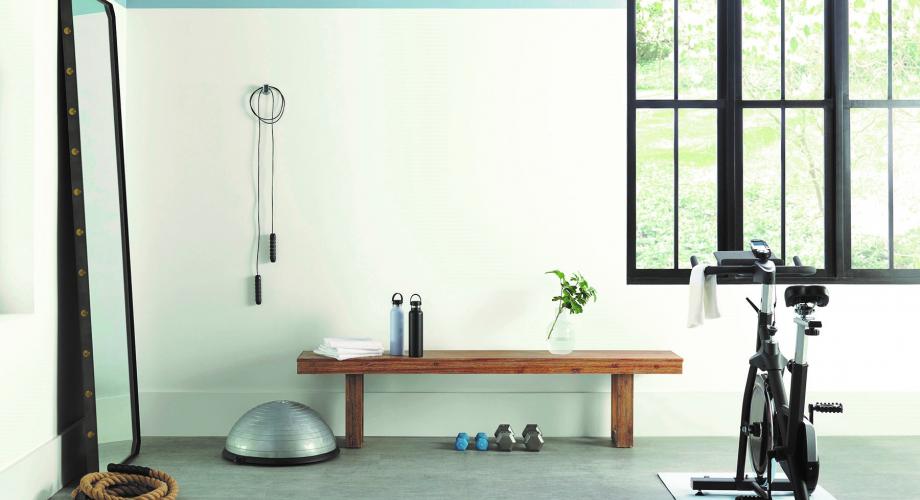Sherwin-Williams Living Well™ Collection includes paints and colors carefully chosen to help you welcome new residents to a haven of comfort, style and well-being. In this article, we explore how paint technology can go beyond the substrate and contribute to a better environment for residents.
Over the past year, people have placed greater importance on creating a clean and safe environment to stay healthy and minimize the risk of disease. The demand for clean surfaces in multifamily communities remains and is prompting manufacturers and professionals to create and source materials that can support a clean environment as well as disinfect and fight harmful bacteria on surfaces in the home.
According to the Environmental Protection Agency (EPA), most Americans spend 90 percent or more of their time indoors, and for many, this means more time spent at home. The EPA also determined that pollutant levels are often two to five times higher indoors than typical outdoor concentrations. This makes it even more important to consider the materials used inside that contribute to how that space functions.
The Power of Paint
Many professionals look at paint as a tool to beautify a space, but in reality, the primary function of paint is to protect what lies beneath. The proper coating can keep vulnerable substrates like steel from rusting, wood from rotting, and keep drywall free of stains and dirt. With the latest advancements in technology, some paints can now do more than protect and enhance a space; they can also help improve indoor air quality or even kill certain bacteria on the paint surface.
Indoor air quality is often a common concern for residents and can be impacted by some indoor materials, including flooring, fabrics, wood products, paint, the chemicals in cleaning products and many more.
When it comes to paint and indoor air quality, there are many factors to take into account, such as volatile organic compounds (VOCs), off-gassing and emission. VOCs are the carbon-containing ingredient found in a variety of products, including paint, while emissions are the VOCs or gasses that evaporate into the atmosphere as the paint dries. Off-gassing, on the other hand, is the release of airborne gasses from a variety of sources, including construction materials.
As more homeowners and residents take indoor air quality into consideration, advancements in coating technologies can help contribute to well-being and help property managers inhibit odors, mold, mildew and certain disease-causing bacteria on the surface.
To meet this need, Sherwin-Williams created the Living Well collection, which includes two products featuring air purifying and sanitizing technologies. Both coatings provide rich, long-lasting color and have the exceptional durability and performance expected of a quality coating while also putting the walls to work. Here are some of the common issues that these coatings can help address:
Improving Indoor Air Quality
SuperPaint with Air Purifying Technology helps improve indoor air quality by reducing VOC levels from potential sources like carpet, cabinets and fabrics. It also works to reduce unwanted household odors so rooms and common areas can stay fresher for longer periods of time. The technology in the coating transforms airborne VOCs into water molecules and harmless inert gas while also deconstructing carbon molecules to reduce and neutralize common odors. In addition, its antimicrobial agents inhibit the growth of mold and mildew on the paint surface, therefore reducing bacterial odors.
While the coating does not add a scented additive to a space, it has the power to break down molecules when odor or VOC molecules come in contact with the painted surface. The length of time SuperPaint with Air Purifying Technology Interior Acrylic Latex actively reduces odors and formaldehyde depends on the concentration, the frequency of exposure and the amount of painted surface area.
Protecting Against Disease-Causing Bacteria
SuperPaint with Sanitizing Technology is the result of a long-term research collaboration between coating scientists and expert microbiologists to create an EPA-registered sanitizing paint. The coating has the power to kill 99.9 percent of Staph (Staphylococcus aureus), E. coli (Escherichia coli), MRSA (Methicillin-resistant Staphylococcus aureus), VRE (Vancomycin-resistant Enterococcus faecalis) and Enterobacter aerogenes on painted surfaces within two hours of exposure. It also continues to kill 90 percent of bacteria for up to four years when the integrity of the surface is maintained, being an ideal solution for high-touch and high-traffic areas in a building.
Professionals and residents can also rest assured that cleaning with their regular cleaning products does not impact the bacterial-reduction performance of the painted surface. While the integrity of the surface is maintained, no special cleaning products will be necessary.
Beyond its innovative technology, SuperPaint with Sanitizing Technology provides excellent durability and dependable performance to give properties a fresh appearance that lasts, ensuring a durable satin finish with quality ingredients that provide excellent hide.
Designing for well-being has taken a new meaning over the last few years, going beyond the look of a space to the different elements that coatings can help enhance. From better air quality to odor-eliminating technology, the right selection of indoor coatings and wellness-inspired hues, property managers can create a haven for residents in their living spaces.
For more information about Living Well and the products, visit s-w.com/livingwell.
